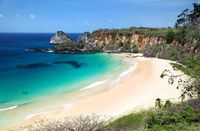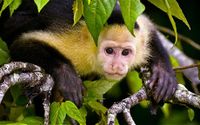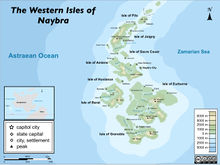Naybra
| This page is a work in progress by its author(s) and should not be considered final. |
This article is a stub. You can help NSwiki by improving it.
| The Western Isles of Naybra NATION NAME
|
|||
|---|---|---|---|
|
|||
| Motto: "Moving on Up" | |||
| Anthem: "Rising Legend" | |||
| Influence | Negotiator[a] (10)
|
||
Official Topographical Map of the Western Isles of Naybra
|
|||
| Region | Hemithea | ||
| Capital | Naybra City | ||
| Largest city | Wagonwater | ||
| Official languages | None at federal level | ||
| Recognised national languages | English[b] and Naybrian | ||
| Demonym | Naybrans | ||
| Government | Federal Presidential Constitutional Republic | ||
| - | President | Ron Harrison | |
| - | Vice President | Brad Carry | |
| - | Speaker of the Chamber | John Kelley | |
| - | Chief Justice | Adam Hennaed | |
| Legislature | NAY Congress | ||
| - | Upper house | Council of Governors | |
| - | Lower house | Chamber of Represenatives | |
| History | |||
| - | Discovery | Date | |
| - | Independence from Gillenorian Empire | Date | |
| - | Recognized | Date | |
| - | Constitution | Date | |
| Area | |||
| - | Total | 1,310,659 km2 814,406 sq mi |
|
| - | Water (%) | 10.2%[d] | |
| Population | |||
| - | 2014 estimate | 33,045,8452[e] | |
| GDP (PPP) | 2014 estimate | ||
| - | Total | NS$90.4 trillion[f] | |
| - | Per capita | NS$77,800 | |
| GDP (nominal) | 2014 estimate | ||
| - | Total | NS$98.2 trillion | |
| - | Per capita | NS$83,100 | |
| Currency | Concull ₵ ( WNC) |
||
| Date format | mm - dd - yyyy | ||
| Drives on the | right | ||
| ISO 3166 code | NAY | ||
| Internet TLD | .nay .gov .mil .edu | ||
| a. | "Influence" Figure updated 3/26/14 from Nation Analysis: Influence | ||
| b. | --- | ||
| c. | The percentage of water estimate is debated among officials as being either too low or too high. The last estimate was calculated 2 years ago by the NAY Ministry of the Environment. Due to a heavy rain season in the past year and new cartography mapping, the new estimate is believed to be higher. | ||
| d. | "Population" estimate was updated 3/26/14 from NSTracker. | ||
| e. | All GDP figures were taken 2/28/14 from NSTracker. | ||
The Western Isles of Naybra, more commonly referred to as Naybra (NAY), the Western Isles, or simply the Isles is a federal constitutional republic, consisting of eight states, each a major island, plus one federal district. All eight islands reside in Hemithea, north the Equator and just southwest of the continent of Euryphaessa. The geography and climate of Naybra is mainly tropical, consisting of three different biomes: tropical rain forest, tropical dry forest, and tropical savanna. The nation's warm and moist climate provide ideal conditions for tourism, the second-largest source of income for the Western Isles.
Naybra was inhabited by eight native Naybran tribes prior to its discovery. These eight tribes had separated themselves among the islands based culture and traditions, but they all worshiped similar gods and spoke slightly different dialects of the same language, which came to be known as Ancient Naybrian. In DATE, Lucile Auffenberg, an explorer of the Artisian Empire, discovered the Isles after a miscalculation in the vessels' course. Realizing that they had run-aground on new land, Lucile Auffenberg notified the Artisian Empire, and began to survey the new land. After receiving the message, a colonial force was sent to colonize the Isles three months later. The later part of the 15th century was taken to fully map and record Naybra and its inhabitants. The Western Isles of Naybra became an official colony of the Artisian Empire on DATE.
When the Artisian Empire collapsed in DATE to the rise of the Gillenor Empire, Naybra was absorbed and became a part of this newly predominant power. As the Gillenor Empire continued to grow, Naybra benefited greatly from its culture and protection. With new ideas, concepts, and technology being introduced by the influx of colonists, Naybra's standards of living were vastly improved. This period, known as the Naybran Renaissance continued after the Gillenor Empire's passing of the Colonial Departments Act of 1768. Through the decades, Naybra served as one of Empire's largest agriculture producers, much thanks to the vast abundance of natural materials and its diverse local wildlife. Naybra continued to supply the Gillenor Empire with many exotic goods and products, leading to the increase of in the colony's importance.
Naybra is a developed country and is Hemithea's eight-largest in terms of GDP, with an estimated GDP in 2013 of $90.4 trillion – __% of the regional nominal GDP and __% at purchasing-power parity. The per capita GDP of Naybra is the region's largest in 2014, estimated at around $77.8 thousand. The economy is fueled by an abundance of natural resources, a partially regulated economy, and an unemployment rate of 3.73%; and while its economy is considered industrial, Naybra continues to be one of the region's largest manufacturers.
Contents
Etymology
History
Precolonial history
Conquest
Colonial period
Rule under the Artistian empire
Rule under the Gillenorian empire
Naybran Renaissance
The Lowlandian Revolution
On October 8, 1806, the The Lowlandian Revolution began with the assassination of Willem II of Orange-Galice. In response, the Gillenor Empire mobilized the Naybran Colonial Army, administered by HM Colonial Office, to reinforce the local NL Colonial Army and protect the Empire's assets in the area. This war introduced Naybra to an industrial revolution, switching from harvesting foods and materials to manufacturing war machines. The Naybran Colonial Army faced many hardships during the war, including guerrilla-style attacks by rebel forces and the failed invasion of Batavia which lasted from late 1814 to early 1815. In January of 1815, delegates from the Gillenor Empire and the New Lowlands met in the capital of the New Lowlands, to negotiate a peace treaty. On January 30, 1816, TREATY NAME was signed by both delegations, essentially ending the conflict. Though they had suffered defeat, the Gillenor Empire rewarded Naybra for its patriotism and sacrifice for the Crown.
Birth of the country
Naybran Bush War
AWAITING OOC DISCUSSIONS AND ROLEPLAY
Early republic
AWAITING OOC DISCUSSIONS
Contemporary era
Geography
Naybra consist of total of fifteen islands, ranging in shape and size. These islands branch off from the southwest of the Hemitean continent Euryphaessa in a " ( " appearance. As an island nation, Naybra shares no land borders with any other Hemithean nation, though the Strait of --- separates Naybra from unclaimed territory. Naybra is bordered on the west coast by the vast Astraean Ocean, while the Zamarian Sea separates the east coast of Naybra from the rest of Euryphaessa. The land area of Naybra is approximately 1.3 million square kilometers, making it the ___ largest territory in region/Hemithea.Despite the ecological diversity of the Isles, Naybra can be categorized into three main natural regions: the Southern region, the Central cluster, and the Northern zone.
- The Southern region includes the two major Isles of Grenoble and Eurborne. Both areas are known for their abundance of natural resources and inhabiting organisms. On the Isle of Grenoble, the Johnson River and the Finney River split Grenoble into two halves. Both rivers originate from the Dormill Range, which resides on the south coast; the most southern point of Naybra. Both Mount Ripley (5621 m) and Mount Vulcan (6278 m) make up a portion of the Dormill. The Isle of Eurborne is divided by four major rivers, the Hollow River, the Bavarian River, the Kettle River, and the Concull River. Again, all streams originate from the mountains, this time from the Brookmere Range. The largest mountain of the Western Isles, Mount Rickana (6432 m), resides on Eurborne's east coast. Mount Rickana is ranked the ___ largest in all of Hemithea.

- The Central cluster includes three major islands of Naybra and the only federal district. The largest of these islands is the Isle of Amiens. Amiens is mainly characterized by Mount Pineborrow, centered directly in the middle of the island. Another geographic feature, Trader Ridge, defines the southern coast. The Roslyn River, in the east, is fed from the mountains, while the Polk River, on the west face, originates solely from Mount Pineborrow. Off the coast of the "fin" of the island rests the federal district Naybra City, a relativity flat area. To the south of Amiens resides the Isle of Hunlance, a small island with only one major geographic feature, the Bay of Moleman. The furthest island south in the Central cluster is the Isle of Barat. Barat has only mountain, Mount Talik, resting on the east coast. Fell's Lake, the second largest lake of the Western Isles, resides at the bottom of this mountain, fed by the Varaby River.
- The Northern zone encompasses a total of three major islands and three minor islands. The furthest north is the Isle of Pilo. Pilo borders unclaimed territory and has a single mountain, Mount Frye. The Isle of Joigny is just to Pilo's south and includes all three minor islands. Along the spine of Joigny is the Blackmill Range. Dead Man's Mountain (6168 m) is the tallest point of the Northern zone. The Wahoo River flows downstream from the peak of Dead Man's Mountain to Millam Lake, the largest collection of water in Naybra. Near the "tail" of Joigny resides the Isle of Sacre Couer, where the elevation does not exceed 3,000 meters.
There are 54 national parks and hundreds of other federally managed parks, forests, and wilderness areas in Naybra. Altogether, the government owns 37.4% of the country's land area; 2.17% of that is used for military purposes. One island off the coast of Joigny is almost completely dedicated to military establishments. It includes naval bases, army training camps, and military surplus storage.

Climate
There is great variety in the climate, largely determined by altitude. Naybra consists of three different biomes: tropical rain forest, tropical dry forest, and tropical savanna.It is humid and moist year-round in the subtropical climate and rainforest areas. The coastal areas mainly have a tropical climate with a long rainy season. The climate in the north is hot and relatively dry. Because of its location near the equator, Naybra experiences little variation in daylight hours during the course of a year.
Biodiversity

Naybra is one of the megadiverse countries in biodiversity, ranking first in bird species. As for plants, the country has between 50,000 and 55,000 plant species, equivalent to 15 or 25% of total regional species; this is even more remarkable given that Naybra is considered a country of intermediate size. Naybra has the most endemic species of butterflies, ranked first in terms of orchid species and has approximately 9,000 species of beetles. Naybra is second in number of amphibian species and is also the second most diverse country in reptiles and palms. There are about 3,200 species of mollusks, and according to estimates there are about 400,000 species of invertebrates in the country.
Environmental issues
Naybra is known throughout Hemithea as one of the purest places in the region. Major environmental issues focus more on the debates of fossil-fuel, hydro-power, and nuclear energy, logging and deforestation, maintenance of national parks and conservation areas, and dealings with air and water pollution. Many regional and federal agencies are involved. The most prominent is the Wilderness and Wildlife Preservation Agency (WWPA), an agency under the NAY Ministry of the Environment. Numerous laws concerning the protection of the Naybran environment, including the Rainforest Protection Act of and the Preservation of Endangered Species Act have also been passed by NAY Congress in efforts to maintain the landscape's natural beauty. Analysis believe that soon, focus will shift from preservation to regulation, including new laws on carbon-dioxide emissions, waste disposal, and noise pollution.



